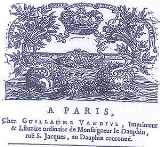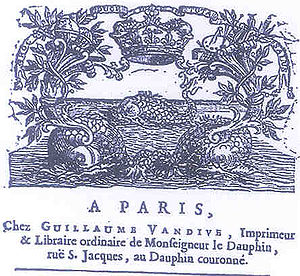
Guillaume Vandive
Encyclopedia

He was the oldest son of the famous Parisian goldsmith of origin of Brussels Philippe Van Dievoet
Philippe Van Dievoet
Philippe Van Dievoet, , was a celebrated goldsmith and jeweller. He was goldsmith to King Louis XIV, conselor of the King and Consul of Paris....
dit Vandive (1654–1738), adviser of the king, goldsmith of the King and the Dolphin, and the nephew of the famous sculptor of Brussels Peter Van Dievoet
Peter Van Dievoet
Peter van Dievoet was a Belgian sculptor and designer of ornamental architectural features. He was born in Brussels, baptised 29 June 1661 in the church of Sainte-Gudule, died 2 March 1729 in Brussels....
(1661–1729).
Personal History
Guillaume Vandive, printer and publisher of Monseigneur the Dauphin, was accepted as a Master on December 20, 1701, with does the recommendation of Monseigneur the Grand Dauphin Louis (who was called Monseigneur, as specified by Lottin), after being trained from April 1697 to April 1701 under Jean Ier Boudot (1651? -1706), ordinary printer of the King and the royal Academy of sciences and director of the Printing works of His Serene Highness the Prince de Dombes with Trévoux. He married in Paris in 1705, Eléonore the Prior. Guillaume and Eléonore had a daughter, Charlotte-Eléonore Vandive.Nicolas Simart succeeded him after having married his widow on June 15, 1706; he received his Mastership the following July.
Its production
It was installed street Saint-Jacob with the sign With the Dolphin crowned , opposite the street of the Parchment factory. It published various catalogs of the books printed at his place into 1701,1704,1706. It points out that it still has other books printed in France or abroad.It also published a series of works in collaboration with Louis Coignard, established street Saint-Jacob with “the Gold Eagle”, born in the 1680 and deceased on September 27, 1738 with the convent of Meung-sur-Loire where it had been transferred a few months before after being embastillé on December 28, 1737 to be implied in the publication of works Jansenists. He was the brother of Elie Jean-Baptiste Coignart (1667–1735) famous to have published the first edition of the Dictionnaire of the French Academy in 1694 and the son of Jean-Baptiste Ier Coignart, printer-bookseller of the king and the French Academy, born in the 1637 and deceased on September 10, 1686.
The catalog of the books published in collaboration with Louis Coignard was published in 1703 in the last pages of the book, Moiens to join together the protestans with the Roman Church publish by evesque Mr. Camus of Belley under the title of Avoisinement of the protestans towards the Roman Church . New corrected and increased edition remarks, to be used as supplement, by Mr. ***, Paris, 1703, at Louis Coignart with the Eagle of gold, and Guillaume Vandive, with the Crowned Dolphin, street S. Jacques, with approval & privilege of Roy (in 12°). The author of this corrected edition would be large the Richard Simon (1638–1712) itself, according to the annotation written in a writing of time on the title page of the specimen which its family preserves. It acts, like says it the first letter prefaces, of a work which addresses to the communities the new ones and new Catholics, and that nearly twenty years after the Revocation of the Edict of Nantes.
It published, only or with its associate Louis Coignard , especially of the recent or new books, in French and sometimes in Latin, covering various subjects, in particular of theology of tendency Jansenist, sometimes of trade, and voyage. Its catalog contains also books intended for the “new converts”. One finds there for example Charles-Joachim Colbert, bishop of Montpellier, the “general Instructions in the form of catechism”, or, of Nicolas Feuillet, “shortened History of the Conversion of Mr Chanteau”, or of works of Henry de Barillon, of Jean-Pierre Camus, Vincent Houdry, Etienne Lochon. It also published “the Perfect one Negotiating” Jacques Savary, increased in this new edition of a “Treaty of the Bill of exchanges”. The Royal Library of Brussels, Reserves invaluable, preserves its presses “Travels of the sir Paul Lucas
Paul Lucas (traveller)
Paul Lucas was a French merchant, naturalist, physician and antiquarian to King Louis XIV. He travelled extensively in Greece, Turkey, the Levant and Egypt, in three major voyages , and ....
to Raising”, 2 volumes, Paris, in Guillaume Vandive, Imprimeur and ordinary Bookseller of Monseigneur the Dolphin, 1704, bindings of red Morocco, armorial bearings of the large duke of Tuscany Cosme III on the dishes.
Its typographical mark, made in homage to the Dolphin, consisted of three surmounted dolphins swimming of a fleurdelized closed crown and two horns of plenty, with the top a listel containing the currency inspired of the legend of the poet Arion: “ hoc duce tuta salus ”: with this dolphin as guide your safety is assured.
Paul Lucas
Paul Lucas (traveller)
Paul Lucas was a French merchant, naturalist, physician and antiquarian to King Louis XIV. He travelled extensively in Greece, Turkey, the Levant and Egypt, in three major voyages , and ....
had been sent in 1699 like “antique dealer of the King” to Raising and in the East, charged with enriching by its lucky finds the cabinets with Louis XIV and its German sister-in-law the Palatine and its book appears, like says it Dirk Van der Cruysse, among the most coloured accounts of voyage most alive and era louis-quatorzienne.
Guillaume Vandive died in full youth at the age of twenty-six years whereas it had founded a printing works and a promising publisher of a bright future.
Its successors
Its successor Nicolas Simart who had married his widow and had become also “printer and ordinary bookseller of Monseigneur the Dolphin”, still a long time continued to print various books of his funds. Thus in 1731, always installed street Saint-Jacob with the “Crowned Dolphin”, it publishes a “new re-examined and corrected edition” of the Voyage of Sieur Paul Lucas with Raising which contrary to the promises of the title page reproduces the original one very exactly.In spite of the fact that it continued to draw throughout its life its subsistence from the printing works founded thanks to the investments from Guillaume Vandive, Nicolas Simart started a sordid lawsuit in 1727 to claim in Philippe Vandive and Balthazar Philippe Vandive the expenses which during twenty years the maintenance and the education of his/her daughter-in-law Charlotte Eléonore Vandive had caused him. He did not hesitate besides to give a noisy publicity to his lawsuit by publishing and spreading on the public place the aggressive indictment of the prosecutor Baron against the arguments of the Vandive family. This indictment preserved at the National library of Paris and written in a style worthy of the Litigants of Root, but in sourer, transmitted the echo of this conflict of interests to us.
No doubt, Nicolas Simart was already in bad financial position and this malicious lawsuit was not to him it great utility, because in 1748 Nicolas Simart was imprisoned for debts with the Caretaker's lodge, where he was still at the first January 1749 according to the Historique of the booksellers of the inspector of Hémery.

